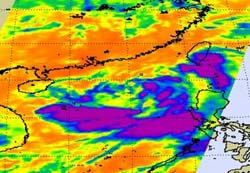Infrared NASA imagery reveals a weaker tropical cyclone in the South China Sea

NASA's AIRS instrument on the Aqua satellite captured this infrared image of 06W on June 20 at 18:05 UTC (2:05 p.m. EDT) when it was still a tropical storm. The purple areas represent icy cold temperatures of -63F/-52C and high, strong thunderstorms. The storm has weakened and appears much more disorganized today. Credit: NASA/JPL, Ed Olsen<br>
On June 21 at 1500 UTC (11 a.m. EDT) the newly weakened Tropical Depression 06W was located about 480 nautical miles east-southeast of Hanoi, Vietnam near 18.8 North and 113.8 East. Depression 06W's maximum sustained winds had decreased to 25 knots (28 mph/46 kmh). It was moving west-southwest at 9 knots (10 mph/17 kmh) and kicking up 11 foot-high waves in the South China Sea.
NASA's Atmospheric Infrared Sounder (AIRS) instrument that flies on the Aqua satellite captured an infrared image of 06W on June 20 at 18:05 UTC (2:05 p.m. EDT) when it was still a tropical storm. Since then, convection has become more scattered and winds have lessened. In addition, the low level center of the storm's circulation has become elongated due to wind shear. Elongation of a tropical cyclone is a sign of weakening.
Because of that wind shear, 06W is expected to barely maintain tropical depression strength before it makes landfall on Thursday, June 23 near Jhan Jiang, China.
The AIRS infrared image captures cloud top temperatures and the coldest temperatures appeared south of the center of circulation. Those cold cloud top temperatures represented the strongest thunderstorms in the tropical storm where rainfall rates could reach up to 2 inches / 50 mm per hour.
Because Tropical Depression 06W has begun moving to the west-southwest, the Joint Typhoon Warning Center has changed the forecast track and taken the depression farther south. The current landfall takes 06W just north of Hainan Island, China and then onto the mainland at the southwestern end of Guangdong province of Southern China.
NASA's Hurricane page: www.nasa.gov/hurricane
Media Contact
All latest news from the category: Earth Sciences
Earth Sciences (also referred to as Geosciences), which deals with basic issues surrounding our planet, plays a vital role in the area of energy and raw materials supply.
Earth Sciences comprises subjects such as geology, geography, geological informatics, paleontology, mineralogy, petrography, crystallography, geophysics, geodesy, glaciology, cartography, photogrammetry, meteorology and seismology, early-warning systems, earthquake research and polar research.
Newest articles

Webb captures top of iconic horsehead nebula in unprecedented detail
NASA’s James Webb Space Telescope has captured the sharpest infrared images to date of a zoomed-in portion of one of the most distinctive objects in our skies, the Horsehead Nebula….

Cost-effective, high-capacity, and cyclable lithium-ion battery cathodes
Charge-recharge cycling of lithium-superrich iron oxide, a cost-effective and high-capacity cathode for new-generation lithium-ion batteries, can be greatly improved by doping with readily available mineral elements. The energy capacity and…

Novel genetic plant regeneration approach
…without the application of phytohormones. Researchers develop a novel plant regeneration approach by modulating the expression of genes that control plant cell differentiation. For ages now, plants have been the…





















